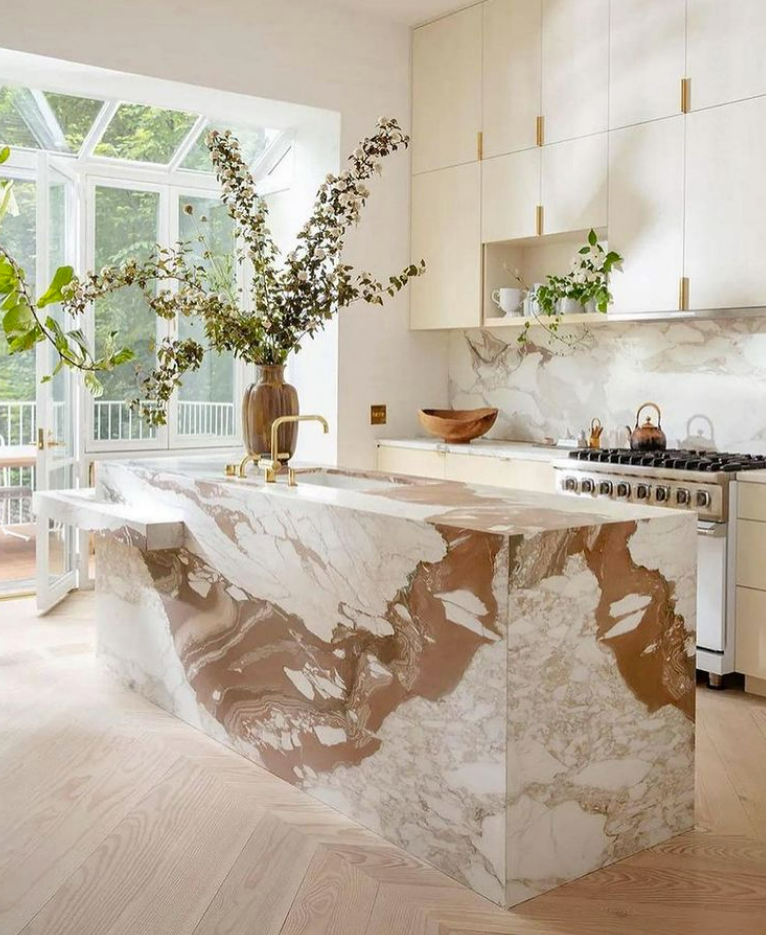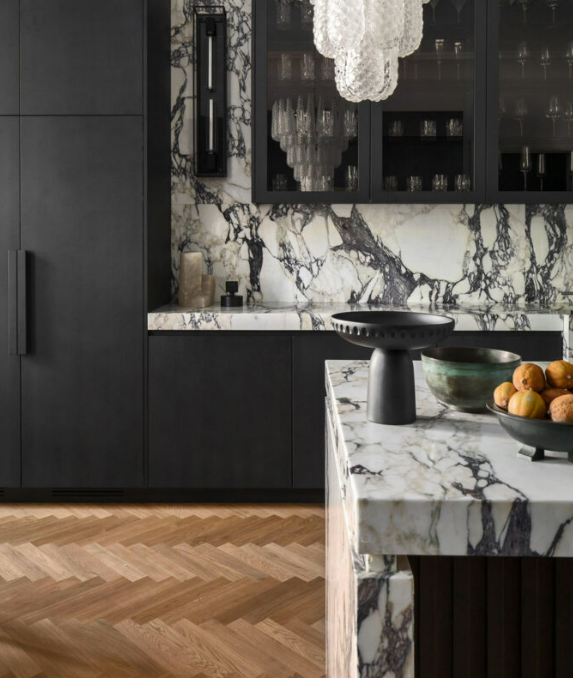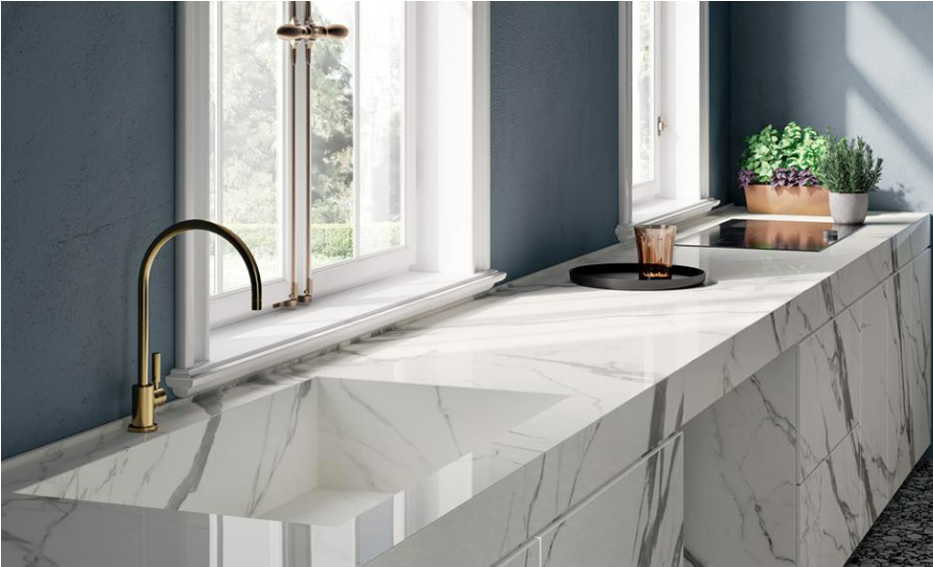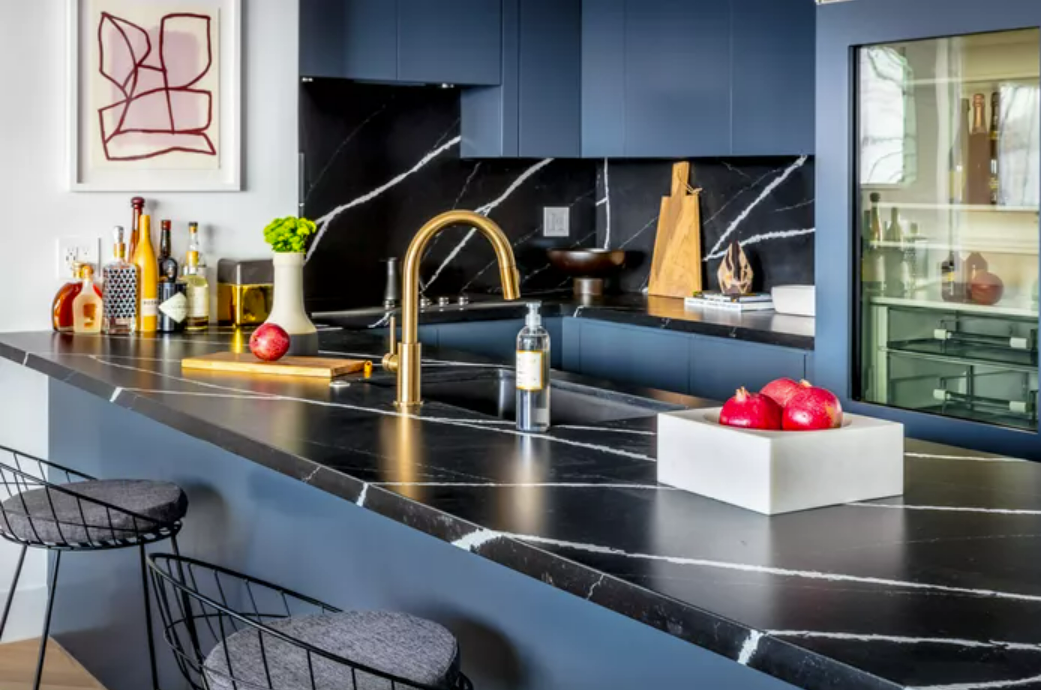How to Choose the Right Kitchen Surface
Choosing the right counter surface for your kitchen renovation project is a major decision. Just think about how much time you spend in your kitchen, putting away groceries, preparing meals, enjoying meals, and cleaning up afterwards. You want your work surface to be beautiful, fitting in with the room’s overall design, as well as functional.
As an interior design studio specializing in high-end residential interiors, we’ve had plenty of experience with kitchen remodels, including layout, cabinetry, fixtures and hardware, and, of course, counter and backsplash selection. In this article, we’d like to share with you our take on which material for your kitchen and island counters is right for your project.
There have always been lots of choices in kitchen surfaces and natural stone is a perennial favorite. However, recently there have been major advances in man-made materials, whose appearance and performance have improved over time. Let’s take a look at the pros and cons of some of the most popular counter materials for your kitchen.
Marble
Classic and luxurious, marble has always been one of the most beautiful and coveted natural stones on earth, since it was first extracted in 300 BC. From pure white Bianco Carrara to the magnificent Calacatta Gold marble, every slab your countertop might be made from is completely unique, with different color intensities and veining patterns.
Here are some of the benefits of using marble for your kitchen countertops:
Luxurious and beautiful for a classic look
One of the longest lasting countertop stones
Available in a variety of colors and types of veining
On the other hand, there are several distinct disadvantages to using marble for your kitchen countertops: it is expensive, it requires regular maintenance, and it has the potential to fade in direct sunlight, which can also magnify dirty or broken marble. Because it is soft and porous, it stains, scratches and chips fairly easily. As a result, it needs to be resealed, as often as every 6 months.
Marble is a fantastic choice, especially in a traditional kitchen, but only if you have the budget for it and the time to maintain it.
Porcelain
Porcelain is a ceramic material that dates back to 600 AD, when it was first used in China. Originally made from a rock called china stone, it was ground to powder and mixed with kaolin, or white china clay. Today’s porcelain kitchen countertops are made from ceramic clay and mineral coloring, resulting in a durable, non-porous surface. They are available in polished and unpolished finishes, and can be made to look like natural stone, wood grain, concrete or rusted steel.
Pros:
· Available in realistic designs
· Durable, as much as 30% stronger than granite
· Heat, scratch, water and UV resistant
· Easy to maintain
· Hygienic, resistant to fungus, mold and bacteria
Cons:
· Cracks under blunt force
· Has limited countertop edge profile options
· Although durable once installed, it can easily crack or chip during the fabrication process
Because it is available in virtually any pattern or shade and can mimic marble and other natural stone, porcelain can be used in any type of kitchen, from traditional to contemporary. Its great for people on the go because it’s so easy to maintain.
You can use porcelain countertops in your outdoor kitchen too!
Quartz
Quartz is an engineered product made from natural quartz crystals that are ground up and fused with polymer resin under high heat and pressure to form a solid slab. Pigments and sometimes small amounts of metallic flecks or glass are added to the mix. Today’s quartz countertop can be as high has 94% ground quartz. Natural quartz is one of the hardest minerals on earth.
Pros:
Uniform in color and pattern
Non-porous and extremely durable
Requires no maintenance
Stain, scratch and water resistant
Available in a variety of designs, colors and patterns, especially marble
Less expensive than marble
Cons:
Not as heat resistant as other materials
Not approved for outdoor use
Can dull knives used directly on the surface
Sensitive to UV light; darker colors may fade
Because quartz countertops are available with a polished, honed, sandblasted or embossed finish, it is highly versatile from a design point of view.If you like the look of marble but don’t have time for the maintenance, then a quarter countertop is a great choice for you.
Granite
Like marble, granite is a natural material. It is an igneous rock composed of quartz and feldspar, a mix which gives it the speckled appearance that makes it so popular. It comes directly from stone quarries. Often considered the gold standard for today’s kitchens, granite countertops are stunning to look at and highly functional.
Pros:
Aesthetically appealing
Durable
Heat resistant
Hygienic
Cons:
Not as stain resistant as man-made materials, and must be resealed annually
Can crack or chip in a corner
Expensive
Perhaps one of the biggest drawbacks is that granite can have a dated look. But if you love to make bread, granite is the perfect choice because of its cool surface. Bakers prefer it because it keeps their dough chilly and its smooth surface makes it ideal for hand-kneading.
If you’re thinking about a kitchen remodel, give us a call. We’d love to help you create beautiful and functional kitchen you’ve always dreamed of.






